Global Environmental Changes
1/78
There's no tags or description
Looks like no tags are added yet.
Name | Mastery | Learn | Test | Matching | Spaced |
|---|
No study sessions yet.
79 Terms
What is global change?
Planetary-scale changes in Earth's system, including land, atmosphere, polar regions, and life.
Encompasses climate change, population growth, economy, resource use, energy development, transport, and more.
Affects the carbon, nitrogen, and water cycles, biodiversity, sea-level rise, and pollution.
What are the natural causes of global change?
Solar variation (sun’s location and orbit).
Plate tectonics and volcanic activity.
Meteorite impacts and resource depletion.
Changes in Earth's orbit and life proliferation.
What is the main modern cause of global change?
Human activity, including:
Population growth.
Increased demand for energy, food, goods, and services.
Waste production and pollution.
Effects include climate change, species extinction, desertification, ocean acidification, ozone depletion, and pollution.
What is pollution?
The introduction of contaminants into the environment, causing adverse change.
Can be chemical substances or energy (e.g., noise, heat, light).
Pollutants may be foreign substances or naturally occurring.
Classified as point source (identifiable origin) or non-point source (diffuse origin).
In 2015, pollution caused 9 million global deaths.
How is pollution defined?
“The introduction by humans into the environment of substances or energy liable to cause hazards to human health, harm to living resources and ecological systems, damage to structures or amenity, or interferences with legitimate uses of the environment."
— Haldgate (1979)
How do we measure toxicity?
Lethal Concentration (LC50): The concentration of a chemical in air or water that kills 50% of test animals after a single exposure.
Lethal Dose (LD50): The amount of a chemical that, when ingested or applied dermally, kills 50% of test animals.
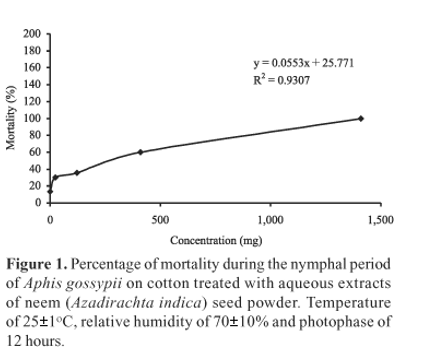
What are the effects of pollutants?
Additive: Effects add up to indicate overall impact.
Antagonistic: One pollutant reduces or cancels out the effect of another.
Synergistic: Pollutants combine to create greater environmental harm than expected.
What are the sources of pollution?
Point source: A single, identifiable origin (e.g., sewage outlet).
Multi-source: Multiple origins (e.g., chimney stacks).
Seeping: Slow, continuous release (e.g., fertilizer runoff).
Spreading: Pollutants dispersed by environmental factors (e.g., volatile chemicals in air currents).
What is acute pollution?
Large amounts of waste enter the environment in a short period.
Often caused by a one-off accidental event from a point source.
Can have severe toxic effects on biota.
Ecosystem begins to recover after the event.
What is an example of acute oil pollution and its biotic events?
Oil spills (Sea Empress, 1996)
65,000 tonnes of crude oil spilled in Milford Haven, UK.
Biotic effects:
90% of sunlight blocked.
Algal cell division inhibited at just 0.01 ppm oil concentration.
Food chains disrupted.
What are the characteristics of chronic pollution?
Low-level input into the environment over time.
Can occur continuously or in frequent pulses.
Causes constant environmental stress, preventing recovery.
Leads to cumulative effects over time.
What are pesticides, and what are their benefits?
Highly toxic chemicals used to kill or control pests and weeds.
Major benefits:
Increased food production.
Reduction in crop and storage losses.
Control of diseases in humans, livestock, and crops.
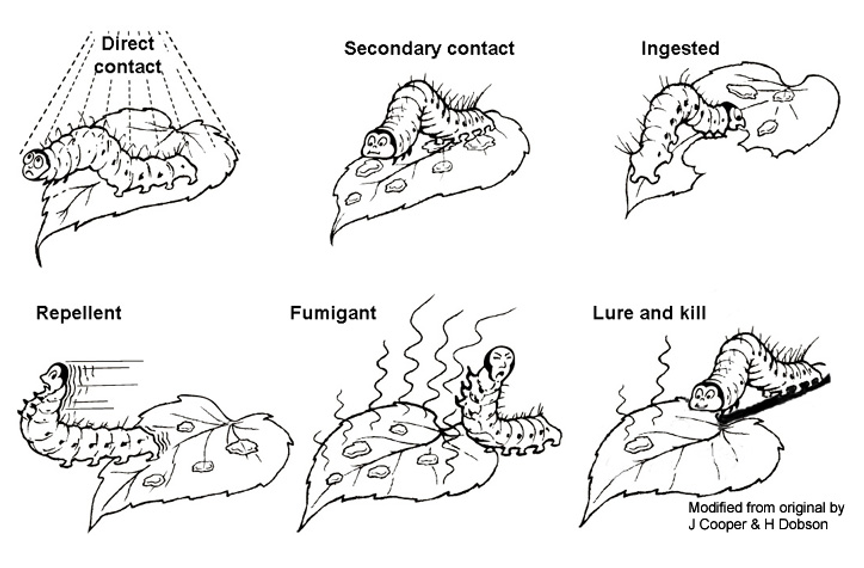
How did DDT affect peregrine falcons?
DDT (Dichlorodiphenyltrichloroethane) was a widely used pesticide in the 1960s.
British Trust for Ornithology (BTO) found that peregrine falcon populations were declining.
High levels of DDE (DDT’s stable metabolite) accumulated in falcon tissues and eggs, leading to population decline.
What are the types of pesticides?
Organochlorines (e.g., DDT, aldrin, dieldrin)
Broad-spectrum toxins, persist in the environment for a long time.
Chlorophenoxy herbicides (e.g., 2,4-D)
Mimic plant auxins, broken down in soil within days.
Organophosphates (e.g., malathion, parathion)
Highly toxic to humans, but biodegradable and non-persistent.
What is biomagnification?
Biomagnification occurs when a chemical moves up the food chain, increasing in concentration at higher trophic levels.
Concentration Factor (CF) = Pollutant in consumer / Pollutant in diet.
Biomagnification occurs when CF > 1.
How has biomagnification affected wildlife?
Example:
1940s: Gnats were a problem → Organochlorine applied at 0.02 ppm.
December 1954: Over 100 Western grebes died due to chemical buildup.
How does plastic pollution impact ecosystems?
Plastic accumulation affects wildlife, habitats, and humans.
Plastics are cheap, durable, but slow to degrade.
Impact on marine life:
Causes entanglement, ingestion, and exposure to harmful chemicals.
Impact on humans:
Can disrupt thyroid hormone levels.
UK Statistics: >5 million tonnes of plastic used annually, only 24% recycled.
What are microplastics?
Small plastic particles (<5mm in diameter) from various sources.
Types:
Primary: Directly manufactured (e.g., cosmetics, clothing, industrial use).
Secondary: Fragments from larger plastic breakdown.
Why are microplastics a concern?
Persist in the environment, especially in marine and aquatic ecosystems.
Can be ingested and accumulated in organisms, disrupting food chains.
How severe is species extinction today?
>90% of all species that have ever existed are now extinct.
Estimated 100-150 species (plants, insects, birds, and mammals) go extinct every 24 hours.
This is 100 to 1000 times the natural extinction rate.
Holocene (Anthropocene) extinction: Ongoing, primarily driven by human activity.
What are the main causes of species extinction?
Habitat fragmentation
Agriculture
Human overpopulation
Deforestation
Poaching and hunting
What is biodiversity?
Short for "biological diversity"—captures the complexity of life.
Defined by the Convention on Biological Diversity as:
"Variability among living organisms from all sources, including terrestrial, marine, and aquatic ecosystems and the ecological complexes they are part of."
Includes diversity within species, between species, and of ecosystems.
What is genetic diversity?
Genetic diversity: The total number of genetic characteristics within a species.
Genetic variability: The tendency of these genetic characteristics to vary within a population.
What is species diversity?
Species diversity refers to the number of different species in an ecosystem.
It consists of two components:
Species richness: The count of species.
Species evenness: How equal the abundances of species are.
How is species diversity measured?
Simpson’s Reciprocal Diversity Index (1/D):
D = Diversity index
S = Total number of species
Pi = Proportion of individuals (n/N) in the i-th species
Higher values indicate greater species diversity.
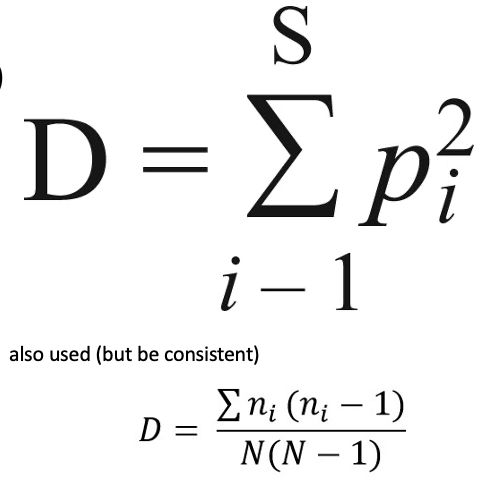
What is Simpson’s Reciprocal Index (1/D)?
A measure of species diversity in an ecosystem.
Formula:
D=∑(nN)2
D = Simpson’s Diversity Index
n = Number of individuals of a species
N = Total number of individuals of all species
Simpson’s Reciprocal Index (1/D):
1/D
Higher values indicate greater diversity.
A value close to 1 suggests low diversity (dominance by one species).
A higher value suggests a more even distribution of species.
What are the three levels of biodiversity?
Genetic Diversity: Variation in genes within a species.
Species Diversity: Variety of species within an ecosystem.
Ecosystem Diversity: Variation in ecosystems across regions or globally.
What is a biodiversity hotspot?
A region with high species richness and high endemism (species found nowhere else).
36 biodiversity hotspots exist globally.
These areas support nearly 60% of the world’s species.
What are the types of biodiversity value?
Direct Use Value: Resources used for consumption/production (e.g., food, medicine).
Indirect Use Value: Ecosystem services that benefit humans (e.g., climate regulation, pollination).
Non-Use Value: Value from existence, cultural, or future potential use.
How does biodiversity contribute to medicine?
Many drugs come from biological sources.
119 pure chemicals extracted from plants.
35% of prescriptions use plant-based chemicals.
Only 5,000 plant species (mostly temperate) have been fully studied for medicinal properties.
How does biodiversity contribute to food supply?
Provides meat, fruits, nuts, vegetables, and food additives (dyes, flavorings, preservatives).
80% of human food comes from just 20 plant species.
Animal consumption varies but is focused on a small number of species.
How does biodiversity support biocontrol?
Natural enemies help manage pest populations.
30% of weed control and 40% of insect control use biocontrol.
Example: Cassava mealybug control in Africa saved £350 million per year.
How is biodiversity important for industrial materials?
Global tree exports worth £4.5 billion.
Over 3.8 million cubic meters of wood harvested yearly for fuel, timber, and pulp.
What are the sustainability challenges related to biodiversity?
Fish stocks:
In 2015, 140 million tonnes of fish were harvested.
66% of marine fish stocks are fished at or beyond sustainable levels.
Fuel-wood crisis:
1.3 billion people in developing countries consume fuel-wood faster than it regenerates.
If trends continue, 1 billion more will face chronic shortages by 2050.
How does ecotourism depend on biodiversity?
250 million people participate annually.
Generates £80–250 billion per year in revenue.
What are ecosystem processes?
The physical, chemical, and biological interactions between organisms and their environment.
Key processes:
Decomposition (breakdown of organic matter).
Primary productivity (energy conversion by plants).
Nutrient cycling (movement of nutrients through ecosystems).
Fluxes of nutrients and energy.
What are ecosystem services?
The benefits ecosystems provide to humans, categorized into four types:
Provisioning – food, water, timber, medicinal resources.
Regulating – climate control, disease regulation, water purification.
Supporting – nutrient cycling, soil formation, pollination.
Cultural – recreation, spiritual value, ecotourism.
Economic value: Estimated at £25 trillion, nearly double the global GNP.
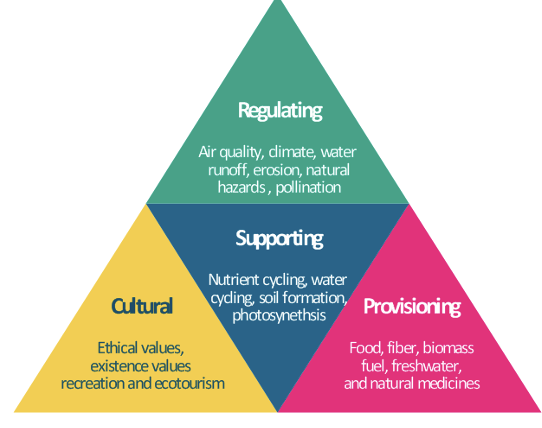
How does species richness impact ecosystem functioning?
Rivet Hypothesis: Species function like rivets; losing too many weakens the ecosystem.
Redundancy Hypothesis: Higher species richness provides functional backups, maintaining ecosystem processes.
Idiosyncratic Hypothesis: The effect of species loss or addition is unpredictable and species-specific.
Complementary Species: More species often enhance ecosystem stability and productivity.
Threshold Effect: After a point, adding more species may not improve or could harm functioning.
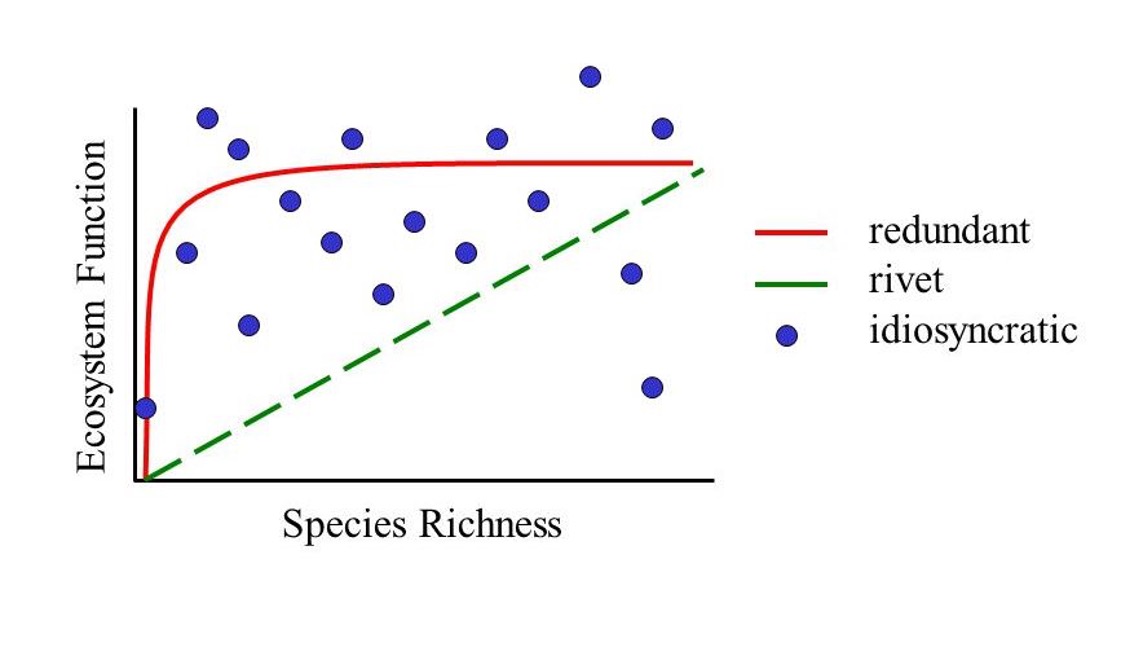
What is The Ecotron Biodiversity Experiment?
Ecotron Experiment: A controlled, large-scale microcosm experiment designed to study the effects of biodiversity on ecosystem functioning.
Setup: Simulates different environmental conditions with varying species richness and community compositions in a controlled environment.
Objective: Examines how biodiversity (species richness) influences ecosystem processes like nutrient cycling, productivity, and resilience.
Key Findings: Demonstrates that higher biodiversity often enhances ecosystem functioning, but results may vary depending on species interactions and environmental factors.
What is the BIODEPTH Experiment?
BIODEPTH Experiment: A large-scale, multi-site study aimed at understanding the relationship between biodiversity and ecosystem functioning.
Setup: Conducted across various grassland ecosystems, examining the effects of different levels of species richness on ecosystem processes.
Objective: Tests how biodiversity influences primary productivity, nutrient cycling, and stability across diverse ecosystems.
Key Findings: Higher species richness typically leads to greater ecosystem productivity and stability, supporting the idea that biodiversity enhances ecosystem services.
What is the non-use value of biodiversity?
Non-use Value: The value placed on biodiversity and ecosystem services without direct or indirect use. This can include "feel good" or "warm glow" values.
Intergenerational Value: Current generations value ensuring biodiversity and ecosystem functioning are available for future generations, even if they don't use it directly.
What is climate change?
A large-scale, long-term shift in Earth's weather patterns or average temperatures.
Can involve warming or cooling over time.
Has Earth’s climate always been stable?
No, Earth has had tropical climates and ice ages many times in 4.5 billion years.
Since the last Ice Age (ended 11,000 years ago), climate has been relatively stable (~14°C).
Recent years show a steady increase in global temperatures.
What are the natural causes of climate change?
Solar Activity: Changes in sunspot activity can influence Earth's temperature (e.g., Little Ice Age).
Milankovitch Cycles: Variations in Earth's orbit, tilt, and wobble affect climate over thousands of years.
Continental Drift: Movement of continents changes ocean currents and air circulation, impacting climate over millions of years.
What are the recent causes of climate change?
El Niño Event: Disrupts global weather patterns, causing temperature shifts.
Volcanic Eruptions: Release gases and particles that can temporarily cool or warm the climate.
Greenhouse Effect: Increased CO₂ and other gases trap heat, leading to global warming.
What is the greenhouse effect?
The greenhouse effect is the process by which greenhouse gases (CO₂, CH₄, H₂O vapor) trap heat in Earth's atmosphere, preventing it from escaping into space. This keeps the planet warm enough to support life but is intensified by human activities, leading to global warming.
Key Climate Change Milestones
1827: Fourier identifies the greenhouse effect
1860: Tyndall measures CO₂ absorption
1896: Arrhenius calculates warming from CO₂
1940: Callender links fossil fuels to global warming
1957: Revelle & Suess highlight CO₂ buildup in oceans
Carbon Dioxide Concentrations Over Time
Pre-industrial CO₂: 260–280 ppm
1990 CO₂: ~350 ppm
2024 CO₂ (Nov 22): ~427 ppm
Predicted 2060 CO₂: ~600 ppm (IPCC)
What are the main greenhouse gases, and how do they differ in effectiveness?
Main greenhouse gases: CO₂, CH₄, H₂O, and CFCs.
CO₂ is the major contributor to the greenhouse effect.
CO₂ is a less effective absorber than other gases.
CH₄ (methane) is about 25 times more effective at trapping heat than CO₂.
Examples of climate change in Wales
• Sea levels at Holyhead increased over past 50 years
• Wheat crops at Aberystwyth flower 1 - 2 weeks earlier
• Blackcap arriving earlier on Skokholm Island
What are the main consequences of climate change?
Sea level rise
Effects on species (habitat loss, extinction risk)
Changes in species distribution (migration, range shifts)
Impacts on agriculture (crop failures, food security issues)
Changes in disease patterns (spread of vector-borne diseases)
Increased human migration (climate refugees, displacement)
What are the IPCC's predictions for sea level rise and its impact?
Predictions:
12 cm rise by 2030
50 cm rise by 2100
Impact:
50% of the global population lives in coastal zones.
Coastal zones are some of the most fertile and lowest-lying areas.
What is the situation regarding sea level rise in the Netherlands?
Land below sea level: Over 50% of the land is below the current sea level.
Protection infrastructure: 400 km of dykes and coastal dunes provide protection.
Estimated cost: The cost of protection against a 1-meter sea level rise is £10,000 million.
What is the situation regarding sea level rise in Bangladesh?
Land below sea level: About 30% of the land is below the 2-meter contour above sea level.
Sea-level rise estimates: Sea level is expected to rise by 1 meter by 2050 and nearly 2 meters by 2100.
Population at risk: 120 million people live in the delta region of the Ganges and Brahmaputra rivers.
What is the impact of sea level rise on low-lying islands?
Population affected: 0.5 million people live in archipelagos of small islands and coral atolls.
Impact of 0.5m sea level rise:
Reduction in habitable area.
Loss of 50% of groundwater.
How does climate change affect freshwater supplies?
Groundwater Impact: Climate change will affect groundwater supplies and reserves.
Population Demand: Increasing population will raise demand for freshwater.
Political Issues: Many of the world’s major water sources are shared, leading to potential political conflicts.
How does elevated CO2 affect C3 plants?
C3 plants generally respond positively by increasing photosynthesis.
Growth in C3 plants increases by about 40% with doubled CO2 levels.
C3 plants benefit from higher CO2 levels but do acclimate over time.
Elevated CO2 increases the carbon to nitrogen (C:N) ratio in C3 plants.
How does elevated CO2 affect C4 plants?
C4 plants show a smaller growth increase (~20%) with doubled CO2 levels compared to C3 plants.
C4 plants also experience an increase in the carbon to nitrogen (C:N) ratio.
How does elevated CO2 affect plant water efficiency?
Elevated CO2 causes partial closing of stomata.
This reduces transpiration, making plants more efficient in water usage.
What constraints affect carbon fixation in plants?
The supply of nutrients may limit the ability of plants to fix carbon efficiently, even with elevated CO2.
How do different genotypes within the same species respond to increasing CO2 concentrations?
Different genotypes within the same species generally show an increased yield as CO2 concentrations rise.
Increased CO2 tends to boost the overall growth and productivity of plants, with varying levels of response depending on the genotype.
What are the indirect effects of increased CO2 on plants and herbivores?
Plants: Leaves may become thicker, have more starch, and increase carbon-based defenses against herbivores due to higher CO2 levels.
Herbivores: Insects that eat plants may be limited by nitrogen supply, requiring them to consume more plants. As a result, they may develop more slowly.
What are the different climate models used to predict shifts in biome patterns?

GFDL: Simulates climate dynamics and biome shifts.
GISS: Focuses on climate change impacts on ecosystems.
OSU: Predicts biome changes based on climate data.
UKMO: Projects global ecosystem shifts due to climate change.
Bars to the left of this line indicate a decrease in original extentBars to the right of this line indicate an increase in original extent
What does the changing distribution of the Speckled Wood butterfly (Pararge aegeria) in Great Britain from 1915–1997 illustrate?
It shows that species distributions can shift over time, often due to environmental changes like climate warming or habitat alteration. The range expansion of this butterfly highlights how organisms may colonize new areas as conditions become more favorable.
What does the distribution shift of the Silver Washed Fritillary (Argynnis paphia) between 1970 and 1997 indicate?
It demonstrates a northward range expansion while remaining stable at the southern boundary, suggesting a response to environmental changes such as climate warming, allowing the species to colonize more northern areas.
What does the distribution data for Cyclamen species suggest?
It highlights changes in plant species distribution over time, which may be influenced by environmental factors like climate change, habitat alteration, or human activity.
What are the effects of climate change on agriculture and cereal production?
Negative impacts partly offset by CO₂ fertilization effect
Overall ~5% reduction in global cereal production
Developed countries: ~5% increase in cereal production
Less developed countries: ~10% decrease in cereal production
Climate change increases disparity in agricultural productivity
What are the potential benefits and challenges of rising temperatures on crop production?
Warmer temperatures lift low-temperature constraints in many regions
However, some crops require cold to initiate germination, which may be disrupted
How does a rise in temperature affect the geographical distribution of crops?
A 1 °C increase in mean annual temperature may shift northern crop boundaries 150–200 km north
This leads to a poleward extension of the northern limits for most crops
How will farming adapt to future climate conditions?
Breeds of animals and crop varieties will change
Adaptations will be made to suit the evolving climate conditions
What factors impact human health, and how does climate change exacerbate them?
Factors impacting health:
Pollution
Inadequate water supplies
Poor soil
Climate change exacerbates these factors, worsening their impact on health.
What are the direct effects of climate change on human health, and can you provide examples?
Main direct effect:
Heat stress due to more frequent and widespread extreme high temperatures.
Examples:
St. Louis, 1998: 5°C above average in August, 50% increase in death rate.
Paris, 2003: 3,000 deaths due to heat.
How could climate change affect the spread of tropical diseases?
Climate change may cause some tropical diseases to spread into mid-latitude regions.
How could climate change impact malaria transmission?
Malaria spread is driven by mosquitoes, which thrive in a temperature range of 15 – 32°C with 50 – 60% humidity.
The IPCC predicts malaria incidence could increase from 45% to 60% of the world population by 2050.
What are environmental refugees?
Environmental refugees are individuals who migrate due to environmental disasters, climate change, or other environmental factors that make their current living conditions unsustainable.
Is climate change happening?
Yes, climate change is happening, evidenced by shifts in weather patterns, rising global temperatures, and other environmental changes.
What is responsible for climate change?
Both natural and anthropogenic factors are responsible.
Natural causes: volcanic eruptions, solar radiation variations.
Anthropogenic (human) causes: greenhouse gas emissions from activities like fossil fuel burning, deforestation, and industrial processes.
What are greenhouse gases, what do they do, and where do they come from?
Greenhouse gases trap heat in the atmosphere and contribute to global warming.
Types include CO2, methane (CH4), nitrous oxide (N2O), and fluorinated gases.
Sources: burning fossil fuels, industrial processes, agriculture, and deforestation.
What are the societal and human impacts of climate change?
Human health risks, economic consequences, food and water security concerns, and migration due to environmental disasters (e.g., environmental refugees).